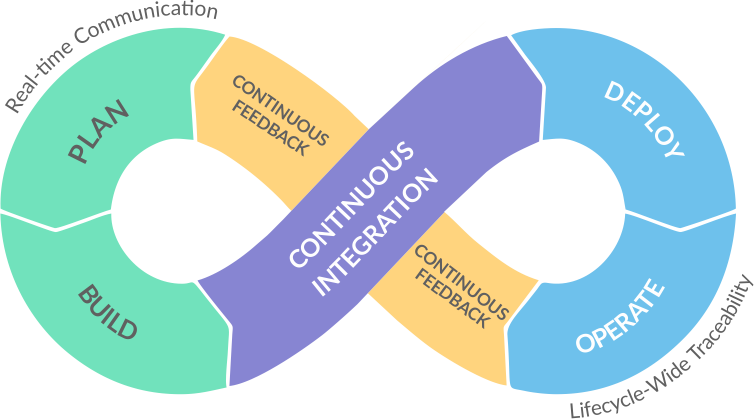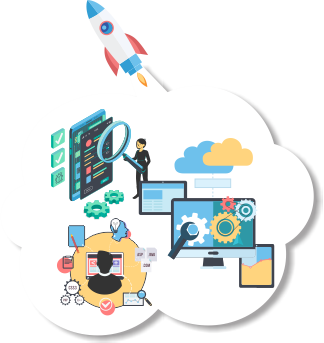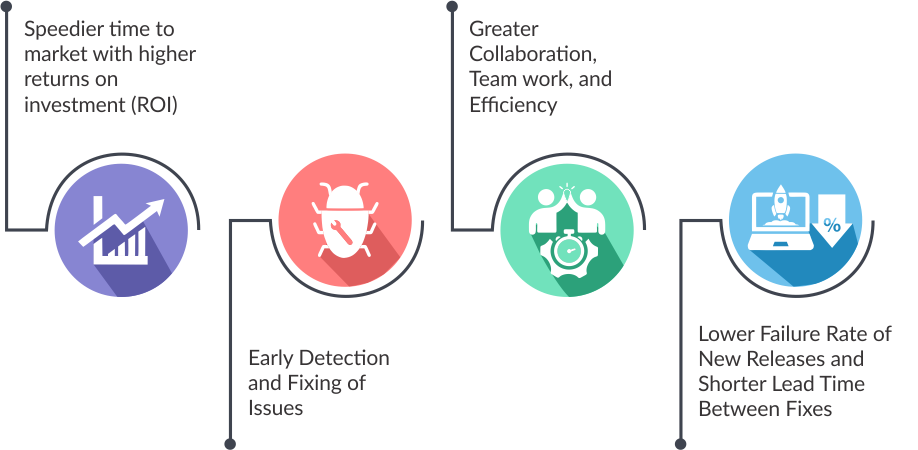What is DevOps testing?
In this comprehensive guide, you’ll learn all about
& Lots more. Let’s get started !
What is DevOps testing?
Advances in agile software development over the years have led to a demand for increased software velocity and throughput. DevOps provided the answer to these demands by bringing a holistic approach to the end-to-end software delivery lifecycle. More than merely a process or methodology, DevOps signifies a paradigm shift in software engineering with a core focus on agility, collaboration, and automation within IT and development team processes.
The traditional silo-based approach involved IT and development working independently within their own teams and processes, which led to frequent communication gaps, lack of alignment and subsequently production delays and software defects. DevOps bridges the gap between development and operational teams through collaboration, seamless engagement, and rigorous alignment with the goal of achieving faster and more efficient delivery while minimizing software defects.
In the Waterfall model, QA and testing tended to occur only at the very end of the software development lifecycle. As a result, much of the feedback and testing results were received too late to incorporate feedback into the software.
Using Agile, development teams frequently released software chunks to customers, regularly incorporating their feedback in the development. DevOps and the nascent Quality Engineering mindset has taken the Agile approach to the next level by focusing on total quality and improving the overall software development process itself.
In the DevOps universe, Quality exists at the fore and center of Development and Operations.
DevOps has given birth to Continuous Integration (CI), Continuous Testing, and Continuous Deployment/Delivery (CD), which allows teams to release build after build, anytime, after automated testing.
Some of the key components of the DevOps testing world are:





- Source code repositories such as Git, Subversion, Cloudforce, and Bitbucket.
- Build servers to compile code from the repository into an executable code base, which include Jenkins, Artifactory, and SonarQube.
- Virtual infrastructure such as Amazon Web Services and Microsoft Azure, which are cloud-based, platform-as-a-service (PaaS) offerings.
- Configuration management tools including pioneering enterprise-grade tools such as Chef and Puppet.
Test Automation is the heart and soul of DevOps. It relies on automation within the build pipeline so as to ensure that testing and development occur in parallel so that when it is time to deploy the build, all tests have already been completed and the product is actually market ready.
- Selenium is an open-source web automation testing tool that supports multiple operating systems, browsers and languages including Python, Java, C#, PHP, Ruby, and Perl.
- Robot Framework works in conjunction with Selenium to enable Continuous Testing and enables a variety of automated tests.
- Testsigma is a test automation platform built on AI for Continuous Testing in a E2E Continuous Delivery ecosystem. It adopts a Shift Left approach to proactively detect errors and provides agility while minimizing the complexities of test automation.
- Rational Functional Tester can be used to create, record, and playback automated functional tests and compare the results produced during actual execution.

DevOps testing strategy
DevOps testing strategy underlines its core philosophy, which is founded on the key principles of automation, frequent iteration, continuous improvement, and a collaborative approach.
- Automation: Everything from workflows to build testing and infrastructure provisioning can and must be automated to maximize efficiency and streamline the lifecycle.
- Frequent iteration: Small code chunks are written in time box sprints and regularly tested to ensure higher software velocity and deployment frequency.
- Continuous improvement: Testing is performed at every stage of the lifecycle and the feedback is continuously incorporated into the new development to ensure that the product performance is continuously being optimized and improved.
- Collaborative approach: Development and Operations teams working in conjunction rather than in silos and Quality Assurance forms the bond between the two, resulting in a unified approach, seamless communication, and higher efficiency.
The DevOps testing strategy enables collaboration throughout the entire development pipeline from concept and builds to deployment and integration.

DevOps cycle
Rather than viewing software development as a monolithic activity, DevOps looks at it as a continuous ongoing process. Continuous Testing is an integral part of the DevOps world view, in which every chunk of code is tested and feeds into the next iteration of the infinite development loop.
To meet the Continuous Delivery goal, the DevOps teams design test automation strategies far ahead on the conventional development curve. As part of this approach, the Development, Operations, and QE teams collaborate from Day One and test automation is deeply embedded into the development process DNA itself. Test automation strategies are devised during the conceptualization stages, which prepares the teams to validate the functionality of assets being developed. It enables quicker feedback early on in the SDLC, unlike conventional approaches that marked Testing as an end-of-cycle activity.
There is a lack of a solid understanding of where exactly DevOps Testing stands in the SDLC, and the answer is that DevOps Testing is everywhere.
The absence of clarity on DevOps testing often leads organizations to fall back on the traditional QA approach. The solution is to develop a clear understanding of what parameters need to be measured and how to identify patterns in the continuous integration and continuous testing framework.
Why DevOps
Why should organizations switch to DevOps thinking at all? What are the issues that riddle the traditional approach?
- Development teams are usually oblivious of both QA and Operational issues. When the issues arise, it forms a roadblock on the development pathway.
- On the other hand, traditional QA and Operational teams work with little or no knowledge of business contexts and have a very limited view of the software features.
- There is typically a lack of alignment of goals of the three different groups, e.g., Development and Operational teams aim to develop and deploy products faster while QA teams need to spend more time to ensure zero defects and higher quality.

DevOps completely reverses the conventional approach. Instead of integrating all three functions — Development, QA, and Operations — at the end of the lifecycle, DevOps integrates them at the very start. Cross-functional teams share the responsibility for Continuous Integration, which ensures compatibility at every stage.
DevOps and Test Automation
To derive the maximum benefits of bringing all the three business functional areas together, DevOps relies heavily on automation across the SDLC to achieve continuous development, integration, enhancement, and delivery. Continuous automation across infrastructure, applications, and compliance enables organizations to deliver software faster, manage risks better, and ensure software security and reliability.
In the DevOps world, nightly builds and weekend regressions are the norm. Consequently the volume of testing goes up exponentially and makes it unmanageable by manual tests. Therefore the success of DevOps is dependent on Test Automation to a fairly large extent.
Test Automation is at the heart of any successful DevOps initiative.
However, Test Automation does not mean that testing happens magically. There is a significant amount of effort and technical complexity involved in building relevant test cases that lead to meaningful inputs for future software development. Test Automation engineers need to have a sound understanding not only of test automation tools and test scripts but also the technical context and business goals.
Once the QA and Development teams develop test scripts and maximize test coverage, they can use Continuous Integration and Continuous Deployment tools to generate builds, deploy, and test them automatically. DevOps also envisages a more proactive role for Test Automation which includes defining strategies where 100% test coverage is not feasible as well as defining, measuring, and analyzing software quality metrics.
The DevOps Process
In a nutshell, the DevOps process is all about collaboration, agility, and automation. In each loop of the DevOps cycle, the teams close the gaps between development and operations through continuous development, integration, testing, feedback, delivery, and deployment.
- Continuous Development describes the iterative process for creating software and also encompasses integration, testing, delivery, and deployment. It helps businesses to achieve faster delivery of new products or features with higher quality.
- Continuous Integration involves frequent merging of code changes by developers into shared repositories where subsequently they are tested automatically. It enables coders to access the latest and validated code base at all times.
- Continuous Testing allows developers to ensure that code chunks function the way they should in a real world or live environment. It helps pinpoint defects and aspects of the software that need improvement or fixing.
- Continuous Delivery involves automatic building, testing, and packaging of code changes for release into production. Continuous Deployment takes it even further E2E automation and no human intervention.

Advantages & Benefits
DevOps solves the major challenges facing traditional IT organizations through its focus on collaboration, automation, and agility:
- Speedier time to market with higher returns on investment (ROI)
- Early detection and fixing of issues
- Greater collaboration, team work, and efficiency
- Lower failure rate of new releases and shorter lead time between fixes
Final Word
DevOps as a methodology unifies the diverse and multi-functional organizational teams with a common goal. It greatly reduces the risks of miscommunication and non-alignment resulting in higher efficiency and higher quality products. Through continuous integration, continuous testing, and continuous deployment, DevOps leads to much quicker time to market and greater customer satisfaction.
Streamline your DevOps testing today to achieve quality at speed. Click here
DO YOU WANT TO CONTROL DIGITALLY?
CONTACT US
